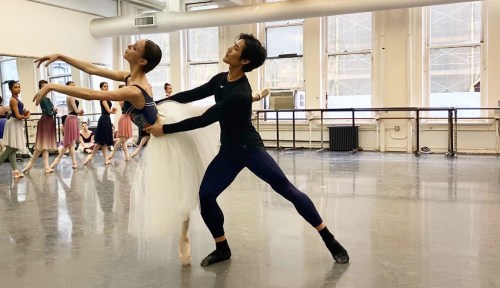‘I’m a Ballerina, and My 3 Go-To Core Exercises Look Nothing Like Sit-Ups or Planks’
Three ballerina core exercises from American Ballet Theatre principal dancer Skylar Brandt—and why she never does crunches or planks.

You’ll never catch American Ballet Theatre principal dancer Skylar Brandt doing traditional core exercises. “As soon as I start to do a plank or a sit-up,” she says, “I feel my back getting very involved, and I also feel like my stomach gets distended.”
Experts in This Article
Skylar Brandt is a principal dancer at American Ballet Theatre.
Instead, the celebrated dancer says that if you were to walk in on one of her core workouts, it’d look like she was hardly working at all. “I like the approach of something more subtle for core strengthening, where you work a little deeper to isolate those small, supportive muscles,” she says. “But you won’t be sweating—you’re connecting to your core in a different way.”
Ballerina core exercises
The exercises Brandt swears by—and practices every week with her Pilates trainer Clarice Marshall—aren’t the kinds of moves that look impressive. (Brandt already does plentyofthose.) They’re slow, and steady, and barely involve much movement at all. “When I was in school, I had the same Pilates teacher and could not understand for the life of me what the benefits of these exercises were,” says Brandt, with a laugh.
As she matured, she realized the challenge comes from performing them incredibly precisely with proper form, activating many of the muscles we typically overlook. “It’s harder to tap those little, linking muscles that connect to the larger ones, but they’re what help me to stay uninjured,” says Brandt. She gets them firing with these three moves:
1. Marching
- 1.Lie on your back with feet flat on the floor, keeping your spine neutral.
- 2.Use your lower abs to slowly lift one bent leg off the floor, without gripping your hip flexors or letting your pelvis tilt sideways.
- 3.Slowly return that foot to the floor, keeping the core stable and hip flexors relaxed.
- 4.Repeat on the other side.
2. Heel slides
- 1.Lie on your back with feet flat on the floor and flexed so toes point toward the ceiling, keeping your spine neutral.
- 2.Use your lower abs to slowly extend one leg forward, heel sliding along the floor, then bring it back toward you without letting the pelvis move or gripping the hip flexors.
- 3.Repeat on the other side.
3. Quadruped limb raise
- 1.Start on your hands and knees, core engaged to maintain a neutral spine.
- 2.Gently lift one hand without shifting or letting that side of the body drop, then replace it back on the ground. You can reach your hand forward, or to tap the opposite elbow, or even just lift it up off the floor a couple inches with a bent elbow—as long as you keep the rest of the body perfectly still, you’ll feel the core firing. “It’s trickier than you’d think—like taking one leg of a table away,” says Brandt.
- 3.Alternate hands, then also try extending one leg at a time straight behind you.
- 4.Once you can stay perfectly still with just three points of contact, try increasing the difficulty by moving the opposite hand and leg away from your center at the same time.
Her other core-strength secret
Brandt only sets aside time to specifically work on these exercises during her once-a-week sessions with Marshall. Her daily method to develop serious core strength is far more straightforward: Maintaining her posture. “If you’re doing it somewhat properly, it engages the core at all times,” she says. For Brandt, that of course means the challenge of keeping her posture stable throughout hours of dancing, but even maintaining it during day-to-day activities can challenge the core.
What constitutes “proper posture” to a ballerina? “My teacher describes it as feeling like the belly button is attached to the spine,” says Brandt. “Some people misconstrue that as sucking in or holding your breath.” Instead, she says, it’s actually about finding a lengthening feeling in the waist, with a long stomach and high upper back.
The bonus benefit of a stable core
In addition to all the other reasons we all want to strengthen our cores—from preventing injury to making everyday activities (like rolling out of bed) easier—Brandt also brings the perspective of someone who works in an aesthetically-driven art form: “A stable core changes your entire appearance,” she says. “It gives a certain strength and power to the whole rest of the body, from the way you use your legs to how you hold your upper chest and back and neck.”
That classic look of grace and power that ballet dancers have? It all stems from the core—but it doesn’t have to take a whole lot of huffing and puffing to get there.
Oh hi! You look like someone who loves free workouts, discounts for cutting-edge wellness brands, and exclusive Well+Good content. Sign up for Well+, our online community of wellness insiders, and unlock your rewards instantly.
Sign Up for Our Daily Newsletter
Get all the latest in wellness, trends, food, fitness, beauty, and more delivered right to your inbox.
Got it, you've been added to our email list.










